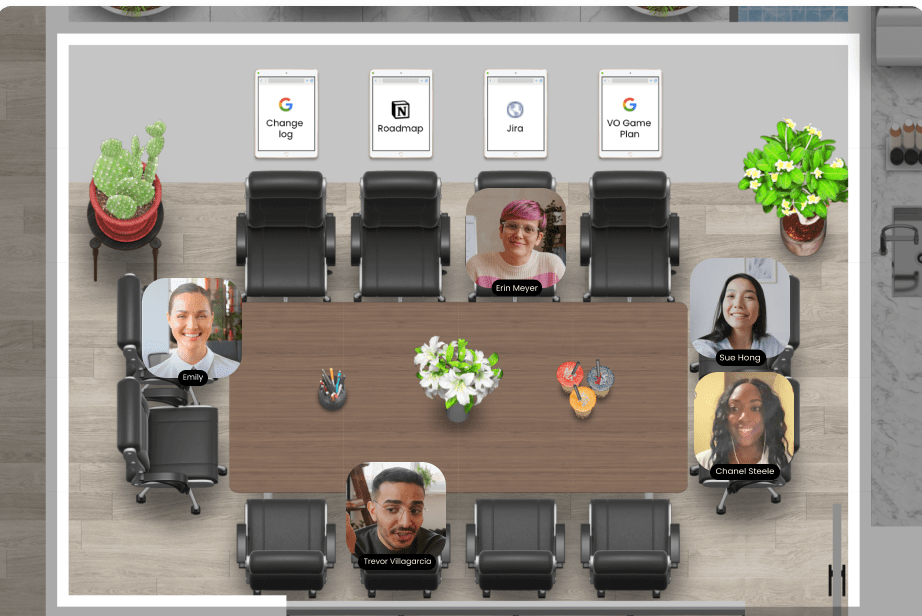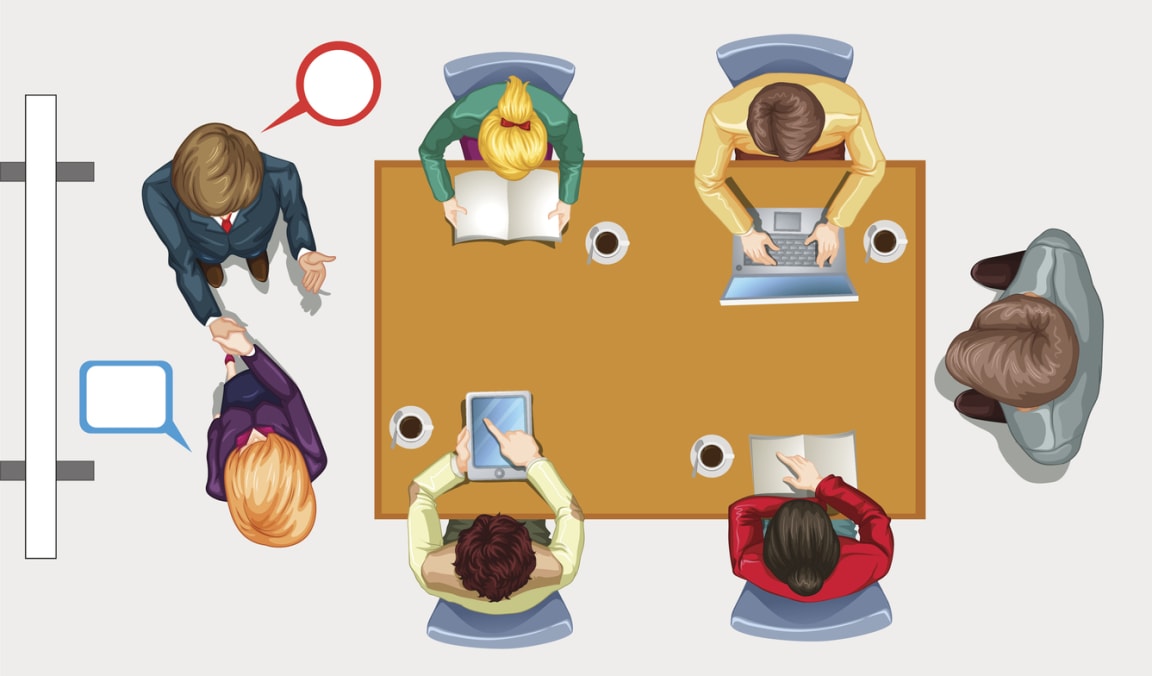If you’ve ever wondered how effective meetings stay on track, ‘the order of business’ is your answer. It’s a critical roadmap that guides participants through every agenda item with precision. In this article, you’ll learn the key steps to creating and following an order of business, ensuring your meetings are organized and productive.
Key takeaways
- Robert’s Rules of Order provides a structured framework for democratic decision-making and meeting efficiency, with adaptability for both in-person and virtual environments such as Kumospace.
- The agenda is central to Robert’s Rules, outlining the sequence and priority of meeting items while allowing adjustments through formal voting processes, to ensure discussions are purposeful and organized.
- Meetings conclude by ensuring all business has been addressed, formal voting on motions to adjourn, and planning for subsequent meetings to maintain continuity and efficient operations.
Establishing the framework: understanding Robert's Rules

Picture this: San Francisco, 1863. U.S. Army officer Henry Martyn Robert is thrust into the unfamiliar role of being the presiding officer over a church meeting. Unfortunately, Henry Martyn Robert finds himself at a loss for how to proceed. This experience sparked a fascination with parliamentary procedure and led to the creation of the first Robert’s Rules of Order.
Fast forward to 2023, and these rules remain as relevant as ever, providing valuable guidance for a wide array of entities from boards and committee leaders to legislative bodies, nonprofits, and start-ups. The most recent edition, the order newly revised, published in September 2020, continues to be a widely utilized parliamentary authority in the US, with an estimated 85-95% of organizations incorporating its principles to conduct business.
Robert’s Rules fundamentally provide efficient meeting procedures and decision-making processes for board members during board meetings, promoting democratic decision-making and giving everyone a voice in a deliberative assembly.
The essence of Robert's Rules
Robert’s Rules pivot around the rules of debate, which are explicitly designed to foster an orderly, fair, and structured discussion during meetings. Imagine sitting in a meeting where everyone wants to speak at once. With Robert’s Rules, the board chair takes on the role of traffic controller, ensuring speakers take their turn and the flow of the meeting is controlled.
This doesn’t mean the rules are set in stone. If the need arises, these can be modified through a two-thirds vote of the members, allowing flexibility in the order of speakers or the time allocated for debate.
Adapting parliamentary law for virtual spaces
In the present digital-first era, virtual meetings have transitioned from being an exception to the norm. However, the challenge of holding orderly meetings persists. Thankfully, Robert’s Rules of Order provides a formal framework for these virtual or hybrid formats. The objective remains the same as in-person meetings - facilitating discussions while maintaining the parliamentary law traditions in a virtual environment.
This is where technology steps in, with platforms like Kumospace offering features that can help facilitate the implementation of Robert’s Rules in virtual meetings.
Crafting the agenda: building your meeting blueprint

Imagine an orchestra without a conductor, or a ship devoid of a captain - that’s the chaos of a meeting without an agenda. In Robert’s Rules, an agenda is a detailed list of items to be addressed at a meeting, serving to provide structure and ensure that meetings are conducted efficiently. The responsibility of drafting the agenda typically falls on the president or chairman, and sometimes the secretary, who must ensure it aligns with the order of business and encompasses items for deliberation.
After being drafted, the meeting agenda is adopted through a majority vote of the entire membership at the commencement of the meeting. Any modifications during the meeting require a two-thirds majority or unanimous consent.
Defining priorities: setting the stage for productive discussion
Within the framework of Robert’s Rules, all agenda items do not hold equal weight. Some items, known as ‘general orders,’ are motions that have been postponed to the current meeting, indicating matters considered important enough to be held over but not reaching a final decision in previous sessions. Then there are ‘special orders,’ items of substantial priority, usually allocated a specific time and place on the agenda to ensure these crucial matters are deliberated with the necessary attention.
Before these, however, comes unfinished business, any motion that was pending at the conclusion of the previous meeting. This prioritization promotes the continuation and conclusion of previously initiated discussions, fostering structure and coherence in meetings.
Incorporating time-sensitive business
Amid the rapid pace of a meeting, time-sensitive items can easily be overlooked. However, Robert’s Rules provides a clear solution by emphasizing the importance of giving these matters priority and allocating sufficient time for their deliberation. These rules also provide a structured and methodical framework for conducting meetings, ensuring that only one item is addressed at a time, thereby guaranteeing thorough attention and discussion for each matter.
Lastly, there are specific procedures outlined for handling urgent matters, such as:
- Verifying the urgency of the subject
- Adhering to the order of precedence for motions
- Examining board bylaws for emergency criteria
- Clearly articulating the purpose in the meeting notice
- Establishing a precise meeting objective with prioritized agenda items.
The call to order: initiating the meeting process in Kumospace

With a meticulously created agenda at your disposal, you can kickstart the meeting. Following Robert’s Rules, the commencement of a meeting involves the chairperson extending a welcome to the gathered members, followed by an official declaration to commence the proceedings. But what if your meeting is not in a boardroom but in the virtual space of Kumospace? Not to worry, the process remains the same.
Designate a ‘chair’ to oversee the meeting, establish specific time constraints, and utilize the platform’s organizational tools. This ensures that even in a virtual environment, your meeting can be just as structured and efficient as an in-person one.
Establishing presence: roll call and quorum verification
Upon calling the meeting to order, verifying the presence of the right individuals is crucial. According to Robert’s Rules, a quorum is the minimum number of members required to validate the proceedings of a meeting in an assembly or society. It is necessary to ensure that decisions and actions are taken with sufficient representation. Determining a quorum is contingent upon the specific regulations of each organization.
It is commonly outlined in the organization’s governing documents and, in the context of a committee or board, specified by an individual who is not affiliated with either group.
Setting the tone: opening ceremonies and introductions
Once the roll call is done and the quorum confirmed, you can proceed to establish the meeting’s atmosphere. Typical practices for opening ceremonies include a call to order, optional opening rituals such as an invocation or national anthem, and the pledge of allegiance. This is then followed by introductions, with each attendee introducing themselves, specifying their name, role or affiliation, and relevant details.
This process not only establishes a formal and respectful atmosphere for the meeting but also ensures that all individuals are acknowledged with respect and their participation is esteemed.
Navigating the meeting map: following the standard order of business

With the official commencement of the meeting, let’s steer through the meeting map. The initial order of business in a meeting following Robert’s Rules is to:
- Address unfinished business
- Propose new ideas
- Encourage participation
Addressing unfinished business
Unfinished business, as the name suggests, refers to any motion that was pending after the previous meeting or issues that were intentionally deferred to the current meeting. This practice of prioritizing the resolution of unfinished business before introducing new items promotes the continuation and conclusion of previously initiated discussions, thereby fostering structure and coherence in meetings.
Proposing new ideas: the new business segment
Once all unfinished business has been attended to, it’s time for new business. This segment of the meeting is where new ideas, topics, and motions are introduced for discussion. New business can be introduced through motions made by members, which require a second to indicate that the idea is worthy of discussion. After addressing new business, the meeting can proceed to further business, if necessary.
Encouraging participation: engaging members in debate
With new business on the table, it’s time to engage in debate. Robert’s Rules of Order can support member engagement during debates by offering a structured framework for discussion and decision-making, guaranteeing that all members have the chance to voice their opinions and ideas.
A structured debate not only fosters a more inclusive and productive discussion, but ensures that majority decisions and minority voices are equally valued.
Decision dynamics: voting and resolutions

While debate and discussion hold significance, the end goal is to reach decisions. The different methods of voting in a meeting include voice vote, standing vote, and ballot vote, each ensuring equitable and efficient decision-making. The type of vote required, whether a majority vote or a two-thirds majority, depends on the nature of the motion or decision being made.
Majority vote vs. two-thirds majority: understanding the difference
Grasping the distinction between a majority vote and a two-thirds majority is vital. A majority vote is defined as a voting method in which over half of the votes cast are in favor of a motion or decision, while a two-thirds majority vote necessitates that at least two-thirds of the votes cast by the members present are in favor of a motion or decision.
The choice between a majority vote and a two-thirds majority vote usually depends on the nature of the motion or decision being made.
Making motions: proposals for action
Making motions is a key part of any meeting following Robert’s Rules. Motions are initiated during meetings when a member proposes an action or decision. This can range from suggesting a new policy to asking for a report to be made.
Once a motion is made within standing committees, another member needs to second it, indicating that the idea is worthy of discussion. The group then deliberates and votes on these motions.
Closing procedures: ending the meeting with order

Like all good things, your meeting too must draw to a close. Before adjourning, it’s crucial to ensure that all essential matters have been deliberated and concluded. Additionally, it is important to ensure there are no outstanding motions or unresolved issues necessitating further deliberation or action.
The formal adjournment of a meeting happens when a board member proposes a motion to adjourn, another member seconds the motion, and the board chair immediately calls for a vote without allowing any debate.
Finalizing decisions: ensuring all business is addressed
Before concluding, verifying that all business items have been dealt with is essential. This means ensuring that all agenda items have been discussed, all motions have been voted on, and all decisions have been finalized. Failing to address all business items during a meeting can have several potential repercussions, including a lack of clarity, missed opportunities, incomplete decision-making, and a negative impact on team morale.
Planning ahead: scheduling the next meeting
Before wrapping up, planning for the subsequent meeting is recommended. Scheduling the next meeting before adjourning is considered significant because it:
- Facilitates a clear roadmap for the future
- Prevents the oversight of important matters
- Enables adequate planning and preparation
- Contributes to the continuity and efficiency of the meetings.
When determining the date and time for the upcoming meeting, it is important to consider the following factors:
- Simultaneous events
- Similar events in other locations
- The time of year
- Competition
- Public holidays
It is advisable to provide multiple date and time options to accommodate the schedules of participants.
Utilizing technology: enhancing parliamentary procedure with Kumospace features

Technological advancements have ushered in novel possibilities for meetings. Platforms like Kumospace can enhance the implementation of Robert’s Rules in virtual meetings. From immersive virtual environments to team chat and screen sharing, Kumospace offers a variety of features that can be tailored to suit the needs of your meeting.
These tools and resources aid in maintaining organization, monitoring meeting progress, participating in discussions efficiently, and even taking meeting notes.
Interactive tools for engagement
The presence of interactive tools is a key benefit of virtual meetings. Kumospace offers a range of features like video conferencing, screen sharing, and real-time collaboration tools that can enhance participation and engagement during meetings.
The incorporation of these tools in a meeting setup can lead to:
- Increased flexibility
- Convenience
- Saved time
- Improved meeting behavior
- Enhanced communication and collaboration
- Heightened productivity
Recording and documentation
Given the numerous discussions and decisions, maintaining a record of the meeting is significant. This is where Kumospace’s recording and documentation features come in handy. These features facilitate effortless capture and preservation of meeting minutes, thereby guaranteeing precise and thorough documentation of discussions, resolutions, and proceedings conducted during the meeting.
This not only ensures adherence to the minutes recording requirements of Robert’s Rules of Order but also acts as an official record of the meeting.
Summary
As we’ve seen, Robert’s Rules of Order is a comprehensive guide that provides a structured framework for conducting meetings, ensuring that all participants have a voice and that decisions are made fairly and democratically. When combined with the advanced features of a virtual platform like Kumospace, it becomes a powerful tool for conducting effective and efficient meetings in the digital age.
Frequently asked questions
The "order of business" refers to the sequence in which business is addressed during a meeting, typically including components like opening the meeting. It serves as a blueprint for the meeting.
The order of business in Robert's Rules is created by following the guidelines for using the rules effectively. It provides a structured way to conduct business meetings.
The first order of business is to define your goals and priorities when faced with a difficult financial situation. This sets the foundation for addressing other issues.
Robert's Rules of Order can be implemented in virtual meetings through platforms like Kumospace, offering customizable features to tailor the meeting to your needs.
To make a motion following Robert's Rules, a member proposes an action or decision during a meeting, and it requires a second from at least one other member before the group deliberates and votes on it.





